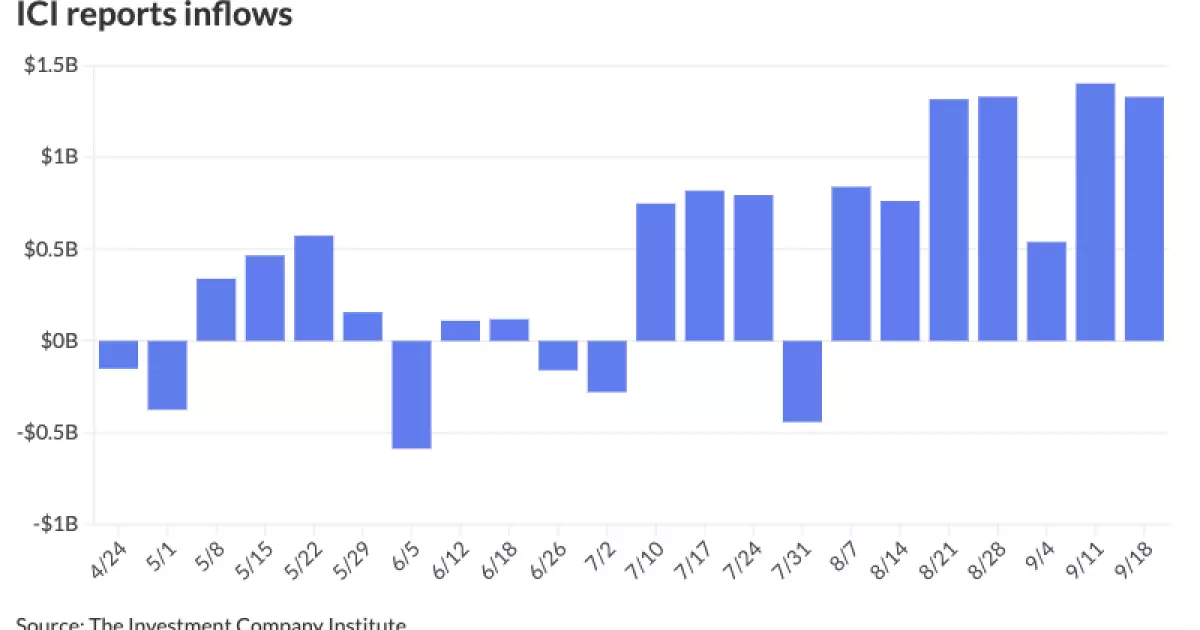The municipal bond market has exhibited a steady pace recently, drawing attention as several high-profile sales witness a subsequent decrease in yields following repricing. While U.S. Treasuries have demonstrated weakness and equities suffered losses, the municipal segment remains comparatively stable. Notably, the Investment Company Institute reported a modest inflow of $1.329 billion into municipal bond mutual funds for the week ending September 18, reflecting a slight decrease from the prior week’s $1.402 billion. Exchange-traded funds trailed similarly, registering inflows of $55 million after a robust $1.048 billion the week before.
This pattern suggests a broader market trend wherein the significant capital influx typical of the summer months is waning as we transition into autumn. Strategists at Appleton Partners cautioned that as we bid farewell to summer, this reduced reinvestment capital could create a volatile environment, particularly during surges in seasonal issuance. Such fluctuations may challenge investors navigating the landscape as they adjust to the diminishing reinvestment “crutch.”
Market Liquidity and Issuance Trends
The current landscape of municipal bond issuance has shown resilience, with the market boasting nearly $14 billion of new supply this week alone. High-profile issuances on Tuesday, including two billion-dollar deals and increased offerings from New York, underscored this trend. Analysts are closely monitoring these movements, especially as year-to-date issuance climbs to a striking $357.913 billion—a 37.7% rise compared to 2023 figures, according to LSEG.
This increase has been partially fueled by mounting apprehensions regarding market volatility ahead of the upcoming presidential election. Issuers appear to be proactively addressing potential fiscal uncertainties, opting to expedite deals before November 5. Abandoning traditional timing norms, many issuers seek to mitigate risks associated with electoral outcomes by raising funds promptly.
Appleton strategists have concluded that the convergence of an increase in supply and limited reinvestment demand may lead to elevated yields, ultimately opening avenues for municipal buyers. As the market adjusts to changing ratios, observations of the 10-year muni-to-U.S. Treasury ratio indicate it currently hovers around 70%, which might increase if the ample supply persists. Such technical aspects reveal a strategic landscape where buyers might capitalize on possible yield advantages.
Pivotal Market Ratios and Yield Dynamics
Shifts in the muni-to-Treasury ratio reflect critical changes to consider for investors assessing the viability of various maturities. For example, the two-year ratio was recorded at 65%, the three-year at 66%, and the longer durations showed ratios of approximately 70% for 10-year issues and around 85% for 30-year maturities, according to Refinitiv Municipal Market Data. Jon Mondillo, the global head of Fixed Income at abrdn, highlighted that long-end ratios have shifted from historical norms of over 100% to the current figures. This evolution may usher in a “new normal” for the industry.
Moreover, to align ratios with historical levels entrenched in a zero-interest rate environment and ultra-low bond yields, a decline in Treasury yields will likely be necessary. This factor injects further uncertainty into the equations that municipal investors must navigate, underscoring the necessity for strategic foresight.
This week, significant transactions dominated the primary market. BofA Securities led the pricing of a substantial $1.061 billion consolidated bond issuance from the Port Authority of New York and New Jersey, with yields presenting minor shifts from previous pricing. The details of these transactions illustrate the intricate dance of price and demand shaping the market.
Furthermore, various other clientele, including educational institutions and state agencies, have lined up remarkable deals, with emphasis on bond ratings. The Cypress-Fairbanks Independent School District managed to secure funding at attractive rates, signifying a robust demand for certain segments of the municipal market.
On the competitive front, the Indiana Finance Authority encountered a successful sale of green bonds. This trend aligns with the broader theme where issuers are increasingly prioritizing sustainability within their financing frameworks.
As we analyze the current landscape, an informed perspective indicates that investors must remain vigilant as market dynamics shift. With the upcoming presidential election looming, fiscal uncertainty could induce fluctuations in investor sentiment and demand patterns. Historically, such events have led to a cautious approach by issuers, who are keen to stabilize their positions ahead of potential disruptions.
As we move forward, the municipal bond market presents both challenges and opportunities. Careful attention to emerging trends, market ratios, and economic indicators will equip investors with the tools necessary for navigating this evolving arena. In a space characterized by complexity, a strategically aligned approach will be vital for successfully capitalizing on market conditions conducive to growth.

